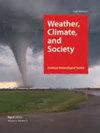结合概率灾害信息预报图形与无线紧急警报讯息:探索性质的研究
IF 1.9
4区 地球科学
Q3 ENVIRONMENTAL STUDIES
引用次数: 0
摘要
自2019年以来,美国国家气象局(NWS)办公室已经能够发布360个字符的龙卷风无线紧急警报(“WEA360”)信息。NWS目前正在考虑将“确定性”预警模式转变为“概率”预警模式。这一变化可能会影响WEA360未来发布龙卷风信息的方式。最近的实验研究发现,概率危害信息(PHI)预测图形提高了消费者对龙卷风的风险感知,但这些研究的结果关于PHI预测图形是否提高了人们的保护行动决策好坏参半。因此,本研究探讨了模拟phi增强的WEA360信息如何影响人们的风险感知和保护行动决策。与科罗拉多州丹佛市的31名社区成员合作,通过问卷调查和焦点小组访谈方法收集了定性数据,分析表明,在WEA360信息中包含PHI预测图形,引起了高度的理解和信息可信度,但并没有始终产生适当的预防意图。由于预警响应是一种复杂的社会现象,如果PHI预测图形最终通过无线紧急警报系统呈现给消费者,那么PHI可能不会显著改善保护行动决策。讨论了在为消费者采用PHI增强的WEA360消息之前,PHI涉众应该考虑的因素。本研究考察了消费者如何回应和谈论包含嵌入式PHI预测图形的龙卷风模拟WEA360消息。当NWS考虑转向概率预警范式时,利益相关者将需要确定如何将PHI预测图形直接传达给消费者,如果有的话。我们的研究结果表明,将WEA360信息与PHI预测图形相结合,会给消费者的个人风险评估和保护行动决策带来挑战和复杂性。总的来说,研究表明,未来任何直接提供给消费者的PHI增强WEA360信息,如果有的话,必须避免PHI预测图表所代表的风险水平与信息文本中包含的保护行动指导之间的差异(甚至是微妙的差异)。本文章由计算机程序翻译,如有差异,请以英文原文为准。
Combining Probabilistic Hazard Information Forecast Graphics with Wireless Emergency Alert Messages: An Exploratory, Qualitative Study
Abstract Since 2019, National Weather Service (NWS) offices have been able to issue 360-character Wireless Emergency Alert (“WEA360”) messages for tornadoes. NWS is now considering changing from a “deterministic” to a “probabilistic” warning paradigm. That change could possibly influence how WEA360 messages for tornado are issued in the future. Recent experimental studies have found that probabilistic hazard information (PHI) forecast graphics improve consumers’ risk perception for tornadoes, but findings from these studies concerning whether PHI forecast graphics improve people’s protective action decision-making are mixed. The present study therefore investigated how mock PHI-enhanced WEA360 messages might influence people’s risk perception and protective action decision-making. Analysis of qualitative data gathered from a combination of questionnaire and focus group interview methods conducted in collaboration with 31 community members in Denver, Colorado, indicated that inclusion of PHI forecast graphics within WEA360 messages elicited high levels of understanding and message believability but did not consistently lead to appropriate precautionary intent. Because warning response is a complex social phenomenon, PHI may not significantly improve protective action decision-making if PHI forecast graphics are eventually presented to consumers via the Wireless Emergency Alerts system. Factors that PHI stakeholders should consider before the adoption of PHI-enhanced WEA360 messages for consumers are discussed. Significance Statement This study examines how consumers respond to and talk about mock WEA360 messages for tornadoes that contain embedded PHI forecast graphics. As NWS considers moving to a probabilistic warning paradigm, stakeholders will need to determine how PHI forecast graphics might be communicated directly to consumers, if at all. Our findings suggest that combining WEA360 messages with PHI forecast graphics creates challenges and complexities related to consumers’ assessment of personal risk and protective action decision-making. Overall, the study suggests that any future PHI-enhanced WEA360 messages provided directly to consumers, if at all, must avoid discrepancies (even subtle) between the level of risk represented by the PHI forecast graphic and the protective action guidance included in the text of the messages.
求助全文
通过发布文献求助,成功后即可免费获取论文全文。
去求助
来源期刊

Weather Climate and Society
METEOROLOGY & ATMOSPHERIC SCIENCES-
CiteScore
3.40
自引率
13.60%
发文量
95
审稿时长
>12 weeks
期刊介绍:
Weather, Climate, and Society (WCAS) publishes research that encompasses economics, policy analysis, political science, history, and institutional, social, and behavioral scholarship relating to weather and climate, including climate change. Contributions must include original social science research, evidence-based analysis, and relevance to the interactions of weather and climate with society.
 求助内容:
求助内容: 应助结果提醒方式:
应助结果提醒方式:


